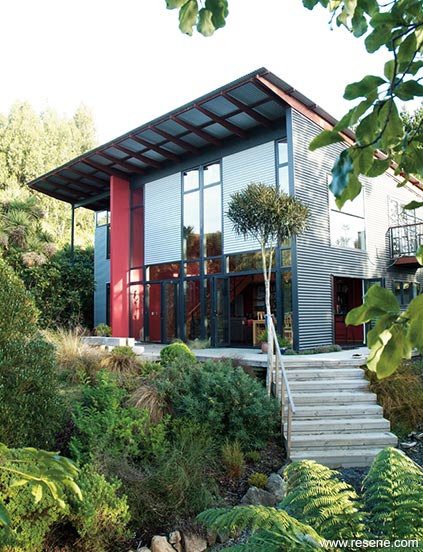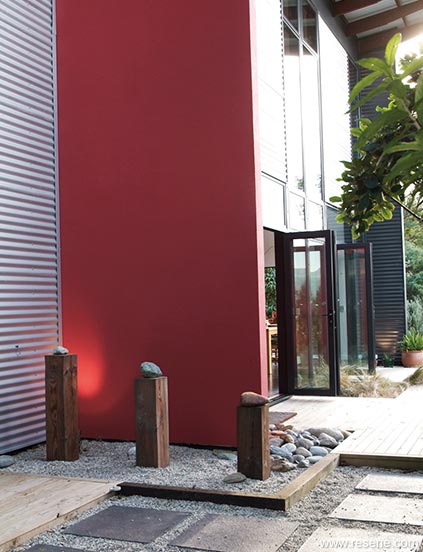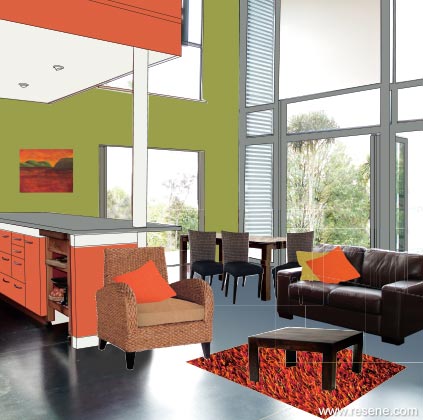From Habitat magazine - issue 05
When homeowners are developing the brief for their ultimate home, they usually expect to take some time over the process. However, they don’t usually have the luxury of 22 years to contemplate their section and make their plans.
Dunedin nurse Helen and academic John did just that. “We bought the section next door to our home 22 years ago. It had a derelict old house on it, which we demolished, and was full of rubbish, which we cleared,” recalls Helen. “We saved one old pohutukawa and a cabbage tree, and spent the years planting more natives.”

Now, the whole section is home to masses of birds: bellbirds, kereru, tui, fantails, warblers and tiny little waxeyes. Today, the urban plot at the edge of the city feels truly rural, which perfectly suits this outdoorsy couple’s lifestyle; when they are not gardening, they love hiking around their corner of the country.
The pair had the luxury of time to observe their land – how the sun fell through the seasons, the best views, the worst winds – and planted around their ideal building platform accordingly. By the time they briefed their architect, Niko Young of Parker Warburton Team Architecture, they knew exactly what they wanted. It was to be a simple, very New Zealand shed, which was energy efficient, collected as much sun as possible, didn’t waste trees and fitted into their native section. In other words, a modern version of a house that settlers have been building in New Zealand for a century or more.
“We didn’t want to make a big impact on the land. The way we’ve planted, the house is not easily seen and takes up only a small part of the section,” Helen explains. “We are very enthusiastic gardeners with New Zealand natives, and we didn’t want a lawn. The decking goes right out to the garden, with gravel paths and pavers outside the downstairs bedroom.”
Niko agrees: “The garden is so fabulous, the building platform just spoke for itself and for the sun. It was just ready for a house to go up there, protected from the wind, but letting the sun through. We knew exactly what we should do.”



With such a strong emphasis on a green building and using passive solar energy for heat, the two-level ‘shed’ with its double-storey void delivers exactly as much living space as the couple needed. Niko stacked two bedrooms and bathrooms on top of each other in one corner of the box, with a kitchen and open mezzanine study stack in the opposite corner. A cosy living room niche is tucked beneath the stairs and upper walkway, lit by a log burner, while the front of the living and dining space is open to two storeys of sun, views and garden. All this fits onto a tiny footprint of only 95sqm.
“This is not a big house, but we get a lot of living. It’s not a house that a family with children would find practical, but we love how open it is,” says Helen. “From the upstairs study, you can look through the top windows to the view and still be connected with the inside.”
The heart of the home for Helen and John is their kitchen, as both cook a lot. Helen is happy the kitchen is not flash, and its layout works very well – with a dash of spicy red Resene Monza to stimulate appetites and conversation. Guests do tend to congregate around the bar with a glass of wine, and even on winter days, the bi-fold doors can be flung open to the dining deck outside.

The open, double-height living room gives into the aforementioned smaller niche, where chairs can be pulled up to the log fire in the winter – and the red does its warming job there too. The mezzanine study is any bookworm’s dream – lined with titles, but with gorgeous views out over the harbour and further to the hills. The upstairs bedroom also shares those views – just as Helen and John had imagined, as they cleared and weeded and planned their home on the hill.
The kiwi pioneer palette of corrugated iron and concrete was given a burst of the modern with Niko’s suggestion of a blade wall bisecting the box from front to back, separating private bedrooms from public living. Helen and John readily embraced his suggested slash of colour – Resene Monza – which contrasts beautifully with the greens and dark trunks of the trees outside and the silvery views of the Otago Peninsula. Floors in a custom-mixed dark charcoal collect the sun’s heat, which is held in layers of polystyrene insulation, and radiate it back into the house after dark.
“Niko clearly recognised our needs, but made it look a lot more attractive with colours and product ideas,” says Helen. “We agreed particularly readily to his colours. At night, with the lights on that red wall, it’s shining and warm and rich. Our art is mostly by New Zealanders like Gordon Walters, Claudia Pond Eyley and Joe Ogier, and we love to add bursts of colour with pieces like our blue skate from the Cook Islands.”
Colour is also found in the hand-painted tiles in the kitchen and bathroom, which are the work of a Christchurch-based artist.


Niko’s attention to storing and using the sun’s heat in the less-than-balmy climes around Dunedin paid off. Even during one of the wickedest winters on record, the house stayed toasty. He ensured the angle of the roof collected the low winter sun, directing it to a southern back wall of concrete, which acts as another heat sink. The roof angle also shades the house in the summer, while fewer windows to the west minimises the baking late summer sun. There are only two tiny south-side windows – in the bathrooms – while the huge expanses of glass across the front are double glazed for a low-e rating. Louvres, and opening windows and doors control the flow of cool air in the summer. The couple have even found that they don’t need curtains for warmth, and they certainly don’t need them for privacy – the trees see to that. The doors and staircase are made from plantation-planted pine instead of native timber.
The compact footprint, without any fancy shapes, the double volumes and borrowing space from the outdoors meant that Helen and John achieved an expansive-feeling house on a very cost-effective budget.
“You do have to invest a bit more up-front on things like low-e glass, double glazing and extra insulation,” explains Niko. “But then your savings on bills mean it costs very little to run the house over its lifetime.”
“The house has achieved everything we’d hoped. I’m still happy to come home here every night,” says Helen. “My favourite thing is to walk around the whole house, not just one favourite room, and look out at the harbour all silver, with maybe snow on the hills. We’re very lucky.”
enhance this open, contemporary space
Celia Faris from Style Issue proposes this alternative scheme on a budget of $5000:

Subtle neutral tones and a circular theme enhance the open, contemporary bones of this space. Using Resene Bianca on all of the existing woodwork gives the room a modern edge, and a wood stain of Resene Waterborne Colorwood Rock Salt over the natural timber of the dining table and chairs creates a soft, blonding finish. Resene Cougar on the rear kitchen wall reflects the lush, earthy tones outside. Three Norm 03 Danish lamps suspended from the ceiling complement the circular porthole mirror. The expansive floor is accented with a beautiful Avis Higgs rug. Fullheight, sheer fabric panels on the windows add a deliberate designer feel. Mounted on oncertina/track panels, they can be stacked one behind the other or extended out to a width of 3.6m.
Celia Faris, Style Issue phone: 03 355 4279
Accessories: Curtain fabric: Création Baumann ‘Typo’, throw fabric: Dandy 802, dining chair and cushion fabric: Leo: Cardinal, from James Dunlop Textiles. Lamps: Norm 03, from Global Piece. Vases, from Redcurrent. Mirror, from Eco Frames. Rug: When the Lights Go on Again by Avis Higgs, from Dilana Rugs.
use colour to contrast and complement
Janet Scard from Janet Scard Design suggests this alternative design:

A contemporary look is created using a combination of bright and cool shades. Limey-green Resene Wasabi on the wall behind the kitchen brings in the colour of the trees from outside and contrasts well with the vibrant orange tone of Resene Oh Behave on the kitchen cabinetry. The remaining walls and ceiling are painted in Resene Travertine. Woven rattan or water hyacinth dining chairs and a pair of water hyacinth lounge chairs add texture and interest. On the floor, a large orange rug brings softness, and orange, green and red cushions on the leather couches and chairs tie in with the colours used elsewhere in the room. A large, square coffee table, with three chunky, red candles on it, anchors the seating area.
Janet Scard, Janet Scard Design phone: 09 535 8726
Accessories: Cushion: Shalimar fabric in Fudge, Soft-back cushions: Linnum in Tangerine, Couch cushions: Linnum in Tangerine, Shalimar in Lime, from Warwick Fabrics. Chair: Lawson Loungers, Coffee table, from Maytime Marketing. Milan dining chairs, from Plantation Cane. Floor rug: Shaggy Retro in orange, from Rug World. Artwork, from Janet Scard Design.
words: Catherine Smith
pictures: Elizabeth Goodall
Search habitat magazine stories
Printed copies of habitat highlights are available from late March 2024 at Resene ColorShops and resellers, while stocks last. You can view back issues of habitat magazine online.
Specifiers:
If you have an idea, project or story that you think would suit habitat, we’d love to hear from you. Please drop us an email with your details and include photos if submitting a project.
Sign up for a DIY card and Save! Australia | New Zealand